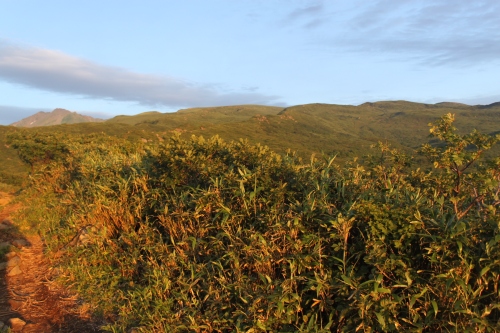Mt. Byobu, Miyagi Prefecture’s highest peak, lies in the southern half of the Zao mountain range. Although I’d been to the Zao range twice previously, it was time to give Minami Zao some attention. The clouds hung heavy over Yamagata city in the early Sunday morning gloom. The second bus of the day wove through the sleepy outskirts of Tohoku’s liveliest city before navigating the switchbacks to the idyllic hot spring resort town of Zao Onsen, where the office of the taxi company sat deserted in the thick fog. I rapped on a door, startling a middle-aged man reclined in a back room. He sprang to attention, offering to drive me to the trailhead at Katta-toge for a mere 8000 yen. I balked at the price, but had no other options considering the only bus off the mountain left at 1pm, a bus I had every intention of making. I bargained him down to 7000 yen and hopped in the back seat.

The road up to Katta-toge meanders through a series of switchbacks across fields overgrown with weeds and pampas grass. In the winter these slopes are home to one of Japan’s most prestigious ski runs, but here in the cloud there was scarcely a sign of human encroachment. A bit further up the plateau, the taxi burst through the cloud perimeter, revealing a massive sea of condensation floating as far as the eye could see. The driver was so moved with the spectacle he shut off the meter just as it reached 6000 yen. “Thanks for giving me a reason to get out of the office”, he exclaimed, turning a glance in my direction with a broad smile stretching from ear to ear. At the trailhead I strapped on the daypack and immediately dove into a dense forest buzzing with the sweet smells of pine and wildflowers. The route dropped gradually to a long saddle that was home to a small emergency hut, which I decided to check out on the return visit. There’s no sense in wasting valuable time scoping out a sleeping space when the weather is cooperative.

I pushed up towards the first peak of Maeyama, through a rocky area perched on the spine of the volcanic massif. Behind me, the mound-like form of Mt, Katta stood tall among the fortress of cloud, the switchbacks of the skyline road stretching across the slopes like the slashes of Freddy Krueger.

The angle eased a bit before dropping to a small saddle at the base of the straightforward climb to Sugi-ga-mine, a nondescript peak sitting at 1745 meters above sea level. The trail was lined on either side by wildflowers of every color imaginable, lending the area to inclusion on the Hana no Hyakumeizan, the venerable list of 100 Famous Flower Mountains of Japan. This was in stark contrast to the igneous minefield of the rest of Zao. Indeed, the volcanic activity had long subsided further south in this range, giving birth to aromatic forests of pine, as well as a lush plateau of wetlands that the local ursine population use as a playground. The area bears a striking resemblance to the rolling hills of Mt. Azuma a bit further south of here, a range that is visible in good weather. By now the cloud had rolled in, wiping out the view and bringing that long promised rain with it. I pulled out my rain cover but continued hiking in short sleeves as the rain jacket would only keep the sweat from evaporating.

On the far side of Sugi-ga-mine the trail dropped yet again, this time losing around 100 meters of vertical elevation before petering out into a marsh. I fueled up here, stuffing some chocolate and almonds into my mouth for the final 1.0km slog to the summit of Byobu. The undergrowth kept most of the moisture away until the creeping pine of the summit plateau left me fully exposed to both the wind and rain, but it was hardly chilly in the mid-August humidity. The views from here must be spectacular here on a blue sky day, but I just had to use my imagination in the fog that grasped tightly to Miyagi’s highest point.

The rain had let up on the return journey, revealing those views that I may have been rewarded with if I had bothered to loiter around on Byobu long enough. By the time I got to Maeyama visibility had all but returned. The lunchtime bells signaling high noon wafted up from a concealed valley on my right, while the businessmen in Yamagata city on my left were just starting to duck out of their offices in search of a cheap bento. I dropped back to the saddle, taking the right fork for the short stopover at the emergency hut. The shed-like structure, built on stilts to help protect the fragile environment, could comfortably sleep 8 people. I used the wooden floor space to stretch out and dry some of my gear while tucking into remaining rations. A small toilet room sat off to one side, marked with signage created by a caretaker with a sense of humor.

After adequate rest, I hit the trail again and turned left to return to where the taxi had dropped me off earlier in the day. Instead of ending the journey there, however, I crossed the road and followed a poorly maintained trail that shot straight up the side of Mt. Katta. Dense vegetation dripping with rain water swallowed the trail, requiring a monstrous effort of swimming, slashing, and ducking. It was easily the most taxing part of the entire hike, leaving me soaked from head-to-toe once the scree fields of the summit plateau were breached. Clouds continued their grip on the plateau as I checked the condition of the emergency hut where I had spend an exciting night during my first visit to the mountain. The fog was some of the thickest I’d seen yet. I’ve had better visibility in a steam sauna as I felt my way through the mess using my feet for navigation. At the bottom of the short descent I spotted the concrete structure of the rest house and visitor’s center, the bus stop sitting in the parking lot directly behind. I had only 5 minutes to spare, so I was left without a clear view of Okama’s elusive crater lake. The peak was clear only 30 minutes before, so I knew it was only a matter of time before the clouds cleared again. Defeated, I trudged towards the bus stop with my tail between my legs. After a quick detour to relieve myself, I plopped down on the soft upholstery of the charter bus that would shuttle me back to Zao Onsen. As the bus navigated through the curves of the skyline road, I reached for my camera to confirm the quality of my pictures. However, my camera was nowhere to be found. I searched under the seat and emptied my pack as panic started to sit in. The last place I had seen my camera was the restroom, when I placed it on the shelf above the urinal. “Noooooooooo”, I screamed.

I hopped off the bus at Zao Onsen and immediately went to the tourist information center to solicit help. After a phone call, the kind attendant had some promising news: “yes, they did find your camera and will hold onto it for you.” Unfortunately, there was a catch: “the hut staff are all based in Miyagi, so if you want your camera you’ll have to either retrieve it yourself or have them mail it to you COD.”
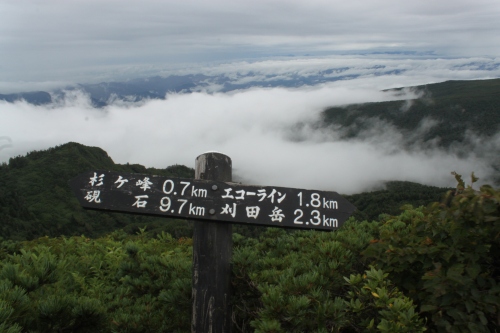
Since I was slowly making my way back down to Osaka, I couldn’t possibly travel without a way to visually document my journey. My original plan was to relax in a hot spring bath, but instead I marched up the road in anger, thumb outstretched in hope that someone would come to my aid. It was already after 3pm and the staff already told me that the rest house closed at 5pm, so I was running out of options. On the march up the road I passed by the entrance to the Zao Ropeway, a ski gondola that whisks visitors to the mountain ridge just below Jizodake. “Aha,” I said, “there is hope after all.”

I abandoned the futile attempts at hitchhiking and bought a one-way ticket aboard the ropeway. “The last gondola is at 4:30pm”, explained the ticket agent. “How on earth are you going to return?” I reassured them that I knew exactly what I was doing and I would simply traverse across the ridge and hitch a ride down from the rest house. This did little to calm their fears, though, so I knew that lying would be my best option in case of further interrogation.
Next I went through the ticket gate, where the attendant once again inquired as to my reason for buying a one-way ticket. “Oh, I’m staying in the hut on the summit”, I answered. There were no further looks of fear or concern as I repeated my answer upon inquiry at every stage of the boarding and alighting process. Fortunately no one questioned my ability to overnight by simply carrying a nearly empty 18-liter pack.
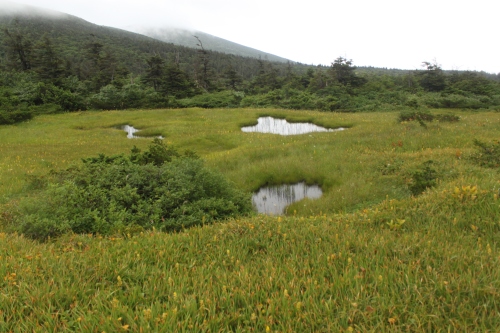
The views from the gondola were breathtaking to say the least, as the mountains continued to float above the immense sea of cloud enveloping all of Yamagata Prefecture. At least 15 of the Hyakumeizan laid stretched out before me, but without a camera I merely had to capture such scenery with my prefrontal cortex. The clouds still hugged the ridge line, however, and once off the gondola and into the fog the real race begun.
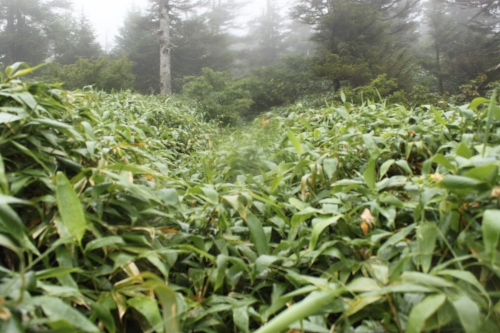
The overgrown path
The map time to the rest house read 90 minutes, but with less than an hour before the rest house closed I went to work. I flew up the steep climb towards the summit of Mt. Jizo, an area I had tramped through during my second visit to Zao. With nothing to see and no camera to capture the scenery anyway, I moved quickly, picking my way though a vast plateau of loose volcanic rock that was punctuated in places by wooden walkways. Beyond the summit the route dropped steeply to a saddle before rising again to the top of Mt. Kumano, Zao’s highest point and target for Hyakumeizan baggers. I reached the summit in only 10 minutes from Mt. Jizo. It was my third visit to the high point and my third time without anything as much as a view. From here, the trail dropped yet again until flattening out on a series of rolling inclines. My pace was a brisk walk averaging around 6 kilometers per hour, so it was hardly a surprise when I rolled into the rest house in less than 30 minutes from the top of the gondola. I asked for the manager, who was as happy to see me as I was him. I had saved him the trouble of having to deal with a lost item, and he had saved me the hardship of my upcoming trip to Chiba without a camera.

I walked back outside and up to the lookout point for the Okama crater lake. Although I had seen the lake clearly during my last visit, it was still caked in a frosting of wintry white, and I desperately longed to see the emerald green hues that draw so many mouth-gaping tourists year after year. I waited patiently as the clouds started to dissipate. Mt. Kumano suddenly came into view, and indeed all of the surrounding peaks were clear of cloud………except for the crater lake itself!

The fog hung heavy around the waters, but gave enough of a tease to satisfy my hunger. With that in hand, I walked down to the parking lot, stuck out my thumb, and immediately got a ride all the way to Yamagata station by a cheery young couple from Fukushima Prefecture.
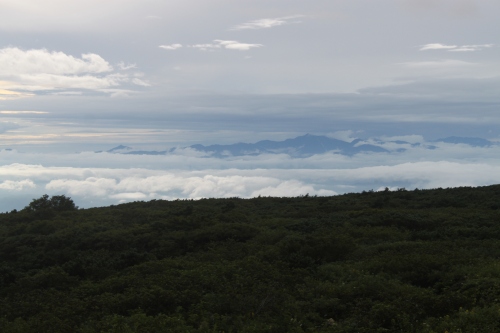
Zao once again put up an unexpected fight. Don’t let the modest size or ease of access fool you: mountains under 2000 meters can create just as much excitement and surprise as Japan’s loftier peaks. You just need to come mentally prepared and with enough flexibility to power through the obstacles. Speaking of which, it looks like my visit was timely indeed, as Okama crater lake is showing signs of increased volcanic activity, which may very well put the entire area off-limits.



